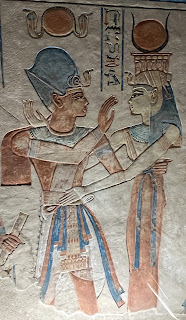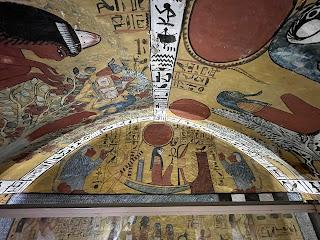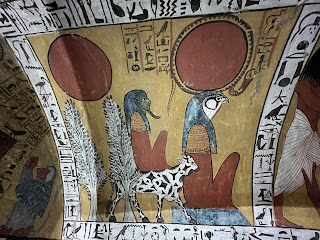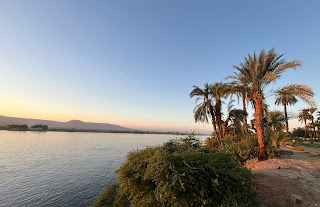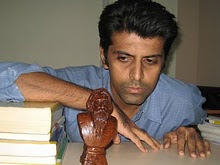Travels with Selkit - 4
OCTOBER 4th, 2024:
At six in the morning, I set out on the bike. 20 odd minutes of exhilatating pedalling (my first spell of cycling in years, this) takes me past the brooding Memnons and the forlorn Amenhotep temple ruins to the fork mentioned at the end of yesterday's log. From a long way off can be seen dozens of hot air balloons, some rising from some site to the north, some others hovering a few hundred feet above ground. Later I am to find out that this balloon flight thing is one of Luxor's highlights; and Luxor is the only place in Egypt that offers balloon rides. At the fork, I decide to go left - it will be valley of queens first.
The limestone hills still have a rosy hue. Their barrenness is perfect - not even cactus. I pedal into a wadi that winds thru the range and am presently at the ticket booth guarding the queen's valley site.
Several tombs have been dug into the walls and floor of the valley. The most famous of them all - Nefertari's - is locked up. I look into a couple among those that are open. Each tomb is built as a series of chambers, stairways and galleries cut into hillsides - From outside, they are merely doorways and steps leading underground. The walls and ceilings of all tombs are illustrated with murals of humans interacting with deities and sometimes going about earthly business. There is also a fair amount of hieroglyphic texts.
From the tomb of Prince Chamuas:
Here, I was most struck by the sophistication in attire. The translucent cloaks (what weaving!), the variety in ornaments and coiffure,...
I dunno what this picture represents:
_____
Note added later: That was a 'Djed pillar' an ancient symbolic representation of Osiris
_____
The glass screens put up in front of the murals are often very irritating with their reflections...
The tomb of Amenkhopshef:
Guess that is the prince greeting Hathor with a friendly embrace:
... and with stiff and staff-bearing Ptah, the Vishwakarma of Egypt:
An amazing heraldic design - the winged sundisk (it also incorporates two hooded cobras) and two winged serpents - same as those forming armrests to king Tut's gilded chair:
Note added later: The Vulture represents Nekhbet and the winged cobra, Wedjet, patron goddesses of lower and upper Egypt respectively.
_______
I leave the Queens' valley without having seen the tomb of any queen (I noticed this slip much later!) and cycle to Deir el Madinah in an adjacent valley. This is the location of the so-called 'artisans' tombs'. Entry tickets are needed but cannot be bought here so I cycle down to the fork on the highway where they can be bought and back - a tiresome exercise that drains off calories and more seriously, time. It is already getting hot...
The tomb of Anherkha: A crazily rich ceiling design with bovines:
Looking down a passage in the tomb with all those irritating screens:
Anherkha (it must be him, looking almost effeminate in that flowing caftan-like garb) in communion with all sorts of strange beings.
That must be him and missus listening to a flabby harpist:
The tomb of Sennutem is right next to Anherkha; is it a little treasure trove!
The different episodes illustrated in the murals appear marked out by frames and that seems one way in which these tomb morals are more modern than say, the temple murals of Kerala - in the latter, everything is jumbled up.
I discover much later with some surprise (from Wiki) that this 'tree goddess' is Nut, the cosmic One:
I dunno what such a batch of squatting deities signifies:
This 'mummification mural' has a very modern layout with illustration and text neatly demarcated:
This must be Sennutem and wife tilling the Elysian fields:
A strange episode - a fanged rabbit cuts down a serpent!
____
Note added later: It's no rabbit but a cat, indeed, its Ra killing Apep, the serpent of darkness (shades of the Indra vs Vritra battle there!)
_____
As I step out of the tomb and walk towards the Ptolemaic temple, a big fellow in a jelabiya tags along. In broken English he says he loves Hindi films and has seen Sholay 10 times.
The temple, though 'only' a little over 2000 years old, has plenty of interesting murals. All I can manage is a quick run thru. Several of the features - for example, the 'boner deity' Min - will repeat over the next few days at several other temples, some of them much older. Still some of visuals here will turn out unique (at least to my knowledge) - for example the jackal headed being in a long cloak holding a big ball!
The remnants of what is said to be some sort of artisans' township dating back to maybe 2000 BC. Incidentally, I dunno if any pharaonic palace from pre Christian Egypt has survived - this colony reminds me of pictures of the streets and houses of Mohenjodaro.
"even this worker's township is bigger than our Lothal, maybe even comparable to Mohenjodaro...and yeah, where are all the other relics of ancient residential architecture here, like the pharaohs's palaces?!..." - my thoughts are interrupted when my (uninvited) companion says with a touch of authority: "come with me, I will show you something!" I follow him onto a hillside. He points at a plank of wood lying on the ground. "Here is something!" he declares and pulls the plank away to reveal a little pit within which are two human skulls. I am utterly stumped. Before I can say anything he says "Here take this, my friend! This is something very old!" and hands me this object:
I can't say if this thing is of any significance - there are some markings on it that are clearly manmade (a single squatting diety?). But some worrisome suspicions are building up within regarding my friend - I look around to make sure we are not too far from other humans.
"Please give me some tip!" I hear him say. I hand over some dough. He is not done: "I make this. Please buy this!" and fishes out something from his pocket.
"100 pounds!" he says. I can't but shell out more money (later, I am to refer to his creation as an 'Amarna cat' for its strange, Marfan-like proportions seem reminiscent of the short-lived style of art introduced by Akhenaton at his capital Tell el Amarna).
He is now beginning to pull out more artefacts from his pocket. But I have recovered sufficiently to say "Sorry, no more. I am not a rich man!" and walk off in a hurry towards civilization.
I still don't know what those skulls are doing in that pit.
It is midday and the sun's glare is piercing thru my hat as I reach the Ramesseum, a temple built by Ramses.
Several statues of Ramses in Osiris-pose, headless, stand like pillars. If they were proper caryatids, that would be even cooler!
Inspiration for Shelley's Ozymandias - a huge colossus, fallen, mutilated, of the mighty king:
It seems Ramses could never get over the near disaster of Kadesh. Here he is again, the Maharathi scattering the Hittites.
These colossal statues remind me of the special effects giants from the 1960s' film 'Jason and the Argonauts':
I am back at the resort by 1.30. The hottest part of the day is spent indoors. By 4.30, I resume the biking exploration and head for the Luxor ferry.
Huge ferry boats run round the clock (Luxor has no bridge). They are quite cheap - just 15 pounds for man plus bike. On the river bank on the city side, stands this military monument, perhaps commemmorating the Yom Kippur war. The bayonet reaching out into space looks like an ancient obelisk.
The day is fading fast. I bike downstream along the river bank. Past the entrance into the huge Karnak temple area is a rundown park. I halt to watch my first sunset over the greatest river on earth.






